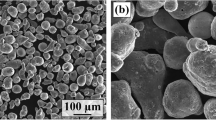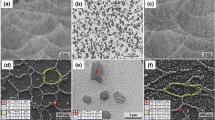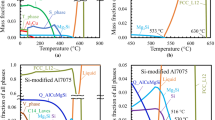Abstract
This work mainly focuses on investigating the microstructural and indentation creep behaviour of heat-treated AlSi10Mg alloy processed via the laser-assisted powder bed fusion (PBF) route. The as-built AlSi10Mg samples were initially solutionized at 520 °C for 2 h. Then, the solutionized samples were aged at 180 °C for 2 h. Indentation creep tests were conducted on the aged sample at three different loads 55, 92 and 129 MPa at 100 °C for 2 h. The steady-state creep rate was calculated from the slope of time vs indentation depth graph. In order to supplement the indentation creep results, detailed microstructural analysis has been carried out through optical and scanning electron microscopy. XRD study was carried out for phase analysis. AlSi10Mg in the as-built condition revealed the eutectic mixture at the melt pool boundaries and ultrafine Al cells in the interior. XRD pattern confirmed the presence of Mg2Si in the age-hardened condition. Several defects were seen in the age-hardened condition. As-built alloy showed the highest hardness, whereas age hardening reduced the hardness due to the spheroidization of Si particles. The primary creep region showed an increase in indentation depth increased with respect to time. The depth of indentation remained constant in the secondary creep region. Age-hardened samples subjected to 92 MPa stress showed better creep resistance compared to 55 and 129 MPa. As-built condition showed the highest hardness due to the extremely fine microstructure.





Similar content being viewed by others
References
Louvis Eleftherios, Fox Peter & Sutcliffe Christopher J. Journal of Mater. Process. Tech. 211 (2011) 275-284. https://doi.org/10.1016/j.jmatprotec.2010.09.019
Ayush Sinha, Biswajit Swain, Asit Behera, Priyabrata Mallick, Saswat Kumar Samal, Vishwanatha H M & Ajit Behera, J. Manuf. Mater. Process. 6(1), (2022) 1-34. https://doi.org/10.3390/jmmp6010016.
Krystian Zyguła, Bartłomiej Nosek, Hubert Pasiowiec & Norbert Szysiak, World Scientific News, 104 (2018) 456-466, EISSN 2392–2192.
Gupta A K, Lloyd D J & Court S A, Precipitation hardening in Al–Mg–Si alloys with and without excess Si. Mater. Sci. and Engg. A 316 (2001) 11-17. https://doi.org/10.1016/S0921-5093(01)01247-3
Sai Deepak Kumar A, Fayaz Anwar Mohammad, Vara Prasad E, Bharath Sreevatsava P & Vanitha C, Mater. Today: Proc. 93 (2021) 1292-1302, https://doi.org/10.1016/j.matpr.2020.04.366
James Anthony LaManna Jr., Doctoral thesis on “A Study of the Relationship between Indentation Creep and Uniaxial Creep”, University of Tennessee, Knoxville.(Knoxville, USA) 2006, 163 , https://trace.tennessee.edu/utk_graddiss/1973, accessed 14th January 2023
Yan Wuzhu, Wen Shifeng, Liu Jun & Yue Zhufeng, . Mater. Sci. and Engg. A 527(2010) 1850-1855. https://doi.org/10.1016/j.msea.2009.11.035.
Bharath Sreevatsava P, and Vara Prasad E, Sai Deepak Kumar A, Mohammad Fayaz Anwar, Vadapally Rama Rao & Vanitha C, Metall. Mater. Eng. 27(4), (2021) 531-539. https://doi.org/10.30544/745.
Yu H Y, Imam M A, & Rath B B, , An impression test method for characterisation of the flow behaviour of superplastic material, Mater. Sci. and Engg. 79(2), (1986) 125-132. https://doi.org/10.1016/0025-5416(86)90395-2.
Ferrar B, Mullen L, Jones E, Stamp R & Sutcliffe C J, J. of Mater. Process. Tech. 212 (2012) 355-364. https://doi.org/10.1016/j.jmatprotec.2011.09.020
Read N, Wang W, Essa K & Attallah MM, Mater. & Des. 65, (2015) 417–424. https://doi.org/10.1016/j.matdes.2014.09.044.
Hammond Vincent, Schuch Michael & Bleckmann Matthias, The influence of a process interruption on tensile properties of AlSi10Mg samples produced by selective laser melting. Rapid Proto. J. 25(8), (2019) 1442–1452. https://doi.org/10.1108/RPJ-04-2018-0105
Naor Elad Uzana, Roni Shnecka, Ori Yeheskelb & Nachum Frage, Addit. Manuf. 24 (2018) 257-263. https://doi.org/10.1016/j.addma.2018.09.033
Tae-Hyun Park, Min-Seok Baek, Holden Hyer, Yongho Sohn & Kee-Ahn Lee, Mater. Charac. 176 (2021) 111113,1-10. https://doi.org/10.1016/j.matchar.2021.111113.
Dongming Li, Ruixian Qin, Jianxin Xu, Bingzhi Chen & Xu Niu, Mater. Charac. 187 (2022) 111882,1-13. https://doi.org/10.1016/j.matchar.2022.111882.
Vadapally Rama Rao, Deepak K. Pattanayak & Vanitha C, Trans. of the Indian Inst. of Met. 76 (2022) 271–277. https://doi.org/10.1007/s12666-022-02663-w.
Shakil S.I, Hadadzadeh A, Pirgazi H & Mohammadi M, Haghshenas M, Micron, 150 (2021) 103145,1-12. https://doi.org/10.1016/j.micron.2021.103145.
Sastry D H, Mater. Sci. and Engg. A 409, (2005) 67-75. https://doi.org/10.1016/j.msea.2005.05.110
Zhuang F K, Tu S T, Zhou G Y &Wang Q Q, The J. of Strain Analy. for Engg. Des. 49, (2014) 482-491. https://doi.org/10.1177/0309324714537056
Suryanarayana C, Grant Norton M, “X-Ray Diffraction: A Practical Approach”, Springer New York, 1998, 207-221, ISBN: 97801489901484 https://doi.org/10.1007/978-1-4899-0148-4.
Bera S, Chowdhury S G, Estrin Y & Manna I, J. Alloys Compd. 548 (2013) 257-265. https://doi.org/10.3390/ma14020430.
Cahoon J R, Broughton W H & Kutzak A R, Metall. Trans. 2, (1971) 1979. https://doi.org/10.1007/BF02913433
Fiocchi J, Tuissi A, Bassani P & Biffi C A, J. Alloys Compd. 695 (2017) 3402-3409. https://doi.org/10.1016/j.jallcom.2016.12.01.
Xianglong Yu & Wang Lianfeng, Proced. Manuf. 15 (2018) 1701-1707. https://doi.org/10.1016/j.promfg.2018.07.265.
Nesma T. Aboulkhair, IanMaskery, ChrisTuck, IanAshcroft & Nicola M.Everitt, Mater. Sci. & Engg. A 667 (2016) 139-146. https://doi.org/10.1016/j.msea.2016.04.092.
Li W, Li S, Liu J, Zhang A, Zhou Y, Wei Q, Yan C & Shi Y, Mater. Sci. Eng. A 663 (2016) 116-125. https://doi.org/10.1007/s42452-019-0270-5
Alghamdi F & Haghshena M, SN Appl. Sci. 1 (2019) 255-265. https://doi.org/10.1007/s42452-019-0270-5
Chen M & Goodman D W, Chem. Soc. Rev. 37 (9), (2008) 1860-1870. https://doi.org/10.1016/j.jcat.2013.11.020.
Iturrioz A, Gil E, Petite M M, Garciandia F, Mancisidor A M & San Sebastian M, Weld. World 62 (4), (2018) 885-892. https://doi.org/10.1007/s40194-018-0592-8
Michael Schuch, Tom Hahn & Matthias Beckman, Mater. Sci. & Engg. A, 813 (2021) 141134,273-286. https://doi.org/10.1016/j.msea.2021.141134.
Alghamdi F, Song X, Hadadzadeh A, Shalchi-Amirkhiz B, Mohammadi M & Haghshenas M, Mate. Sci. & Engg. A, 783 (2020) 139296,1-12. https://doi.org/10.1016/j.msea.2020.139296.
Takata N, Kodaira H, Sekizawa K, Suzuki A & Kobashi M, Mater. Sci. and Engg.A 704 (2017) 218–228. https://doi.org/10.1016/j.msea.2017.08.029
Aboulkhair N T, Tuck C, Ashcroft I, Maskery I & Everitt N M, Metall. and Mater. Trans. A 46 (2015) 3337–3341. https://doi.org/10.1007/s11661-015-2980-7.
Acknowledgements
The authors thank National Institute of Technology Warangal and CSIR-CECRI, Karaikudi for providing the experimental facility. CSIR-CECRI manuscript communication number CECRI/PESVC/Pubs/2022-150.
Author information
Authors and Affiliations
Corresponding author
Ethics declarations
Conflict of interest
The authors declare that they have no known competing financial interests or personal relationships that could have appeared to influence the work reported in this paper.
Additional information
Publisher's Note
Springer Nature remains neutral with regard to jurisdictional claims in published maps and institutional affiliations.
Rights and permissions
Springer Nature or its licensor (e.g. a society or other partner) holds exclusive rights to this article under a publishing agreement with the author(s) or other rightsholder(s); author self-archiving of the accepted manuscript version of this article is solely governed by the terms of such publishing agreement and applicable law.
About this article
Cite this article
Vanitha, C., Rao, V.R., Sashank, C. et al. Indentation-Derived Creep Response of Age-Hardened AlSi10Mg Fabricated Through Powder Bed Fusion Process. Trans Indian Inst Met 76, 3437–3445 (2023). https://doi.org/10.1007/s12666-023-03020-1
Received:
Accepted:
Published:
Issue Date:
DOI: https://doi.org/10.1007/s12666-023-03020-1




